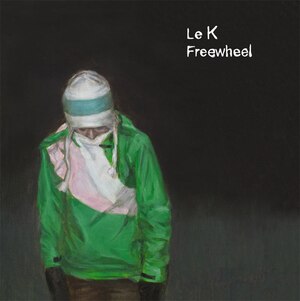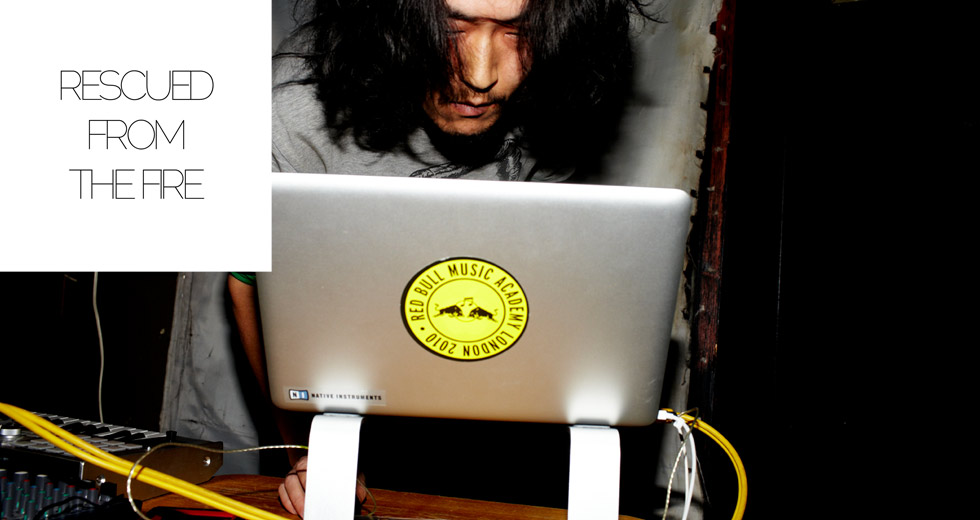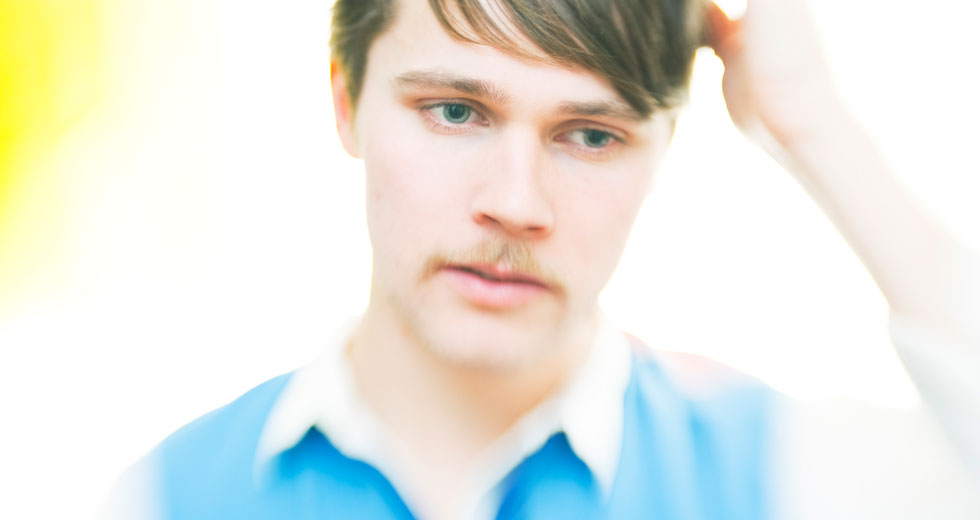Interview: Le K
Sylvain Garcia has been known to drop a few surprises on dancefloors – usually as part of his live sets, which saw him build oddball house grooves out of all manner of synthetic samples and found sounds.
But he’s caught everyone off-guard this year with his debut album Freewheel, which spins a line through jazz-influenced electronics, fluid drum patterns and conveyor belt soundscapes while still maintaining the off-kilter Le K signature. We caught up with the 2006 participant while he was back home in the south of France, taking some time off from rehearsals with up-coming singer Lippie, to find out more about his album-making process.
So how long have you been working on Freewheel? You can tell there’s a lot of care and attention to detail gone into it.
It took me about nine months to produce this album. As soon as I knew I was going to be a father, I started working on it, and I finished the last serious mixing session in the first month of [my daughter's] birth at home. I had three intense writing and production sessions of two weeks each: alone and isolated, in some houses I rent here in the Pyrénées. I spent hundreds of hours working on arrangements, sound design and details, completely losing the sense of time, and dedicating everything to music. Tiring moments, but absolutely wonderful. I had a quest, you know?
I’d say you’re mostly known for your live performances, and the crafting of house rhythms out of unusual atmospheres and sounds. How did you find translating that live energy to an album? They’re pretty different mindsets, aren’t they?
Well, I didn’t have to translate or transpose anything at all for the simple reason that I completely changed everything in my music for this album, at least from what people may know from me. Honestly, I was tired of my own productions and shows, it didn’t make any sense anymore to me. I became completely allergic to entertainment in music for a while, I didn’t want to play this character anymore. The quality of my production was ten levels behind what I knew I was able to do. Of course, there were some bits in my music that I knew were valuable, but I suddenly had this desire for rebirth – and most of all, to be able to recognize myself entirely in my own music. I first got very depressed by all of that, but waiting for the arrival of my daughter changed my behavior and gave me a big boost.
I decided to put time on my side, because time is not something we value a lot nowadays.
I started everything from scratch, with nothing inside my computer, and built a library of unique sounds by myself (with field recordings, recording instruments, and sampling records, etc). The live energy that I used to give during my shows became an energy of devotion and faith in what I was making. Honestly, I’ve never been so focused in my whole life.
I also see there’s an album launch this week. What will that live show look like? Has it been a challenge to bring the album to the stage?
Well, yes, the album was supposed to come out this week but we had to postpone it due to administrative issues. But we kept this release party in Paris with Baby Ford and Thomas Melchior.

I’ve played a few times with the sounds that I’m gonna do tomorrow, but I’m constantly developing it, mostly the way I can interact with my sequences. So, basically it will sound like my album, but more dancefloor oriented, and at least half of the set will be pretty slow (between 115 and 119 bpm). In a way it’s a challenge, because I fill the sonic space with quite a lot of frequencies and sounds, mixed with massive drum beats, which is not that popular nowadays. But the few times I tested it, it worked very well, so I’m pretty confident. I just keep in mind that I wanna transcribe the tone and mood of the album in a dancefloor context. This is great because dance and body music is still very important to me.
You’ve had a few records out over the years, why do you think it has taken so long to present your debut album?
Yes, as I told you I decided to take a break from all this stuff, and to be honest releasing EPs wasn’t what excited me the most. I actually finished this album almost two years ago, but it was necessary to wait a long time. I first sent something like six or seven demos to my favourite big underground electronic labels of all time (Warp, Ghostly, !K7 and few others), just a simple CD in a flat pack. I knew that the chance of me getting an answer from any of them was very small. I know the business pretty well now, and I doubt that they listen to a demo if nobody has recommended it – at least not all of it. Then I kept the album at home for a few months. I just let some of my good producer friends listen to it but no one else.
Take it easy, I’m not some mystic weirdo!
I was very busy with my child and the touchAble Project, and I really wanted to know if time would leave my work unimpaired, to know if I could get the same degree of intensity while listening to it. For once in my musical life I decided to put time on my side, because time is not something we value a lot nowadays, and the electronic music and dance music world is the perfect example of that. Something can sound fresh for three weeks, then you listen to it two months later and it doesn’t make sense anymore. That’s a very frustrating feeling though. The goal was to avoid all kinds of trendy clichés, and a bit of time was the only thing to make sure of that!
So for a few months I just had regular listening sessions of my album and every time I felt very satisfied with it. Believe me, that’s for the first time in my life, and it’s a wonderful feeling. In the meanwhile Laetitia and Alex, the owners of Karat Records, who are my good friends, had time to listen to it carefully and said that they really would like to release the album, without any kind of changes. I liked the idea of releasing my debut album on one of the labels which pushed me to switch from rock to electronic music.
Tell us a bit about touchAble, was much of the album made using that?
Actually, I just finished the album while we started to work on touchAble (an iPad controller app for Ableton Live) with my partner Christian Blomert, so I didn’t use it. But there is a bunch of functionality implemented which come straight from the experience of my album. A lot of production stuff that I felt was missing, combined with the experiences of my live act, fed the core of the app. I’m really happy to know that thousands of people, including great artists, use touchAble everyday. We’ve received so much good feedback over the last eighteen months.
There’s lots of musical influences on the album, plenty of jazz inflections, as well as some kind of UK 1990s electronic feel. Who are some of the musicians that inspired you for this record? And were there also some non-musical inspirations?
Yeah absolutely, a blend of all of that. I’ve been listening to jazz music for quite a long time, I recently spent a couple of years learning jazz harmony, scales and stuff like that at the music conservatory. Not that I wanted to play jazz (I’m a guitar player), but it was very important to get this theoretical background, in order to override its rules. During the writing and production sessions of the album, I listened to quite a lot of jazz – mainly post and hard bop but not only – such as Thelonious Monk (my favorite musician of all time, along with Frank Zappa), Miles Davis, Charles Mingus, Ornette Coleman, Joe Henderson, Wayne Shorter, Sun Ra, John and Alice Coltrane, Don Cherry, Pharoah Sanders, Lalo Schifrin, Eric Dolphy, Clifford Brown and Art Blakey. The UK 90s electronic feel comes probably from my electronic music education, which seriously started in the middle of the 90s with some of the biggest Warp artists: Aphex Twin, Squarepusher, Autechre, Plaid, LFO. That music blew my mind at the time!
I try to listen to an album from the beginning to the end... There’s an odyssey offered to you if the album is good.
But I also fed my ears with a lot of ethnic music from Morocco, Mali, Gambia, Niger, Congo, Vietnam, Bali, Northern India, Pakistan and Mongolia. Also quite a lot of electroacoustic music by Parmegiani, Ferrari, Pierre Henry, François Bayle, Stockhausen, and of course a lot of contemporary electronic and dance music by Tim Exile, Burial, Four Tet, T++, Pepe Bradock, Pole, Deadbeat, Caribou, Isolée, Bruno Pronsato, Clark, Jan Jelinek, Pantha du Prince, Kenny Larkin, Maurice Fulton and Hieroglyphic Being among others. So the result is unconsciously a mix of all of that, founded over eclecticism but with a sonic signature. Non-musical inspirations were mostly the nature, and a constant reflection on the cycle of life due to the coming of my daughter. But take it easy, I’m no mystic weirdo!
Do you feel the album format is a bit of an overlooked commodity these days, in the world of digital releases and labels?
That’s a good question. I’m afraid it is for the new, young generation, the one that’s been discovering music only through digital. I’m 35 years old, I grew up with cassettes, my father’s vinyl and, later, CDs. It’s a different approach for sure. I mean, as far as I can, I try to listen to an album from the beginning to the end, not to skip through it, because I know there’s meaning beneath the track order. There’s an odyssey offered to you if the album is good. Not a compilation of tracks, an album. But the market doesn’t push consumers to buy and listen to albums in this way nowadays. It’s more like ‘let’s play tracks randomly from my computer amongst my 300 gigabytes of music’.
I’m absolutely not against digital. I mean, it’s a wonderful way to expand our quest for music. But I guess you need a bit of background for that, and growing up and listening to music like in the old time is certainly key. But personally as an artist, I really need to release an album. I want to offer 70 minutes of my musical universe to the people who make the effort to dedicate this time to it. At the beginning, I wanted to have the album digitally available as one track, so there was no way to buy (or illegally download) separate tracks, but I don’t want to play Don Quixote. Let’s see what will happen. Frankly, it’s just another album among the 500,000 already released since the start of the year!
The video animation for Freewheel looks interesting. Who did that, and how did that come about?
One of my best friends Nicolas Alberny made it, who I was in a band with for ten years. I just gave him a blank canvas and he made these dream-like images. He’s a very talented director, his last feature-length movie was called 8th Wonderland and the original version is in English. Some video clips will follow made by different directors. I just want to give them maximum freedom, I’ve been enough of a control freak with my own music.
What’s in store for the rest of the year for Le K?
I guess we’ll release probably one or two vinyl EPs with some original tracks and remixes, and an album compilation of remixes – some made by friends I’ve known since RBMA 2006 in Melbourne. After that, I don’t know. I have a couple of remixes for artists in the making, I’m starting to work on the second album and I have some other music projects with some pretty well-known dudes, but I can’t say anything yet. I just hope promoters will let me defend my music in the next months.

